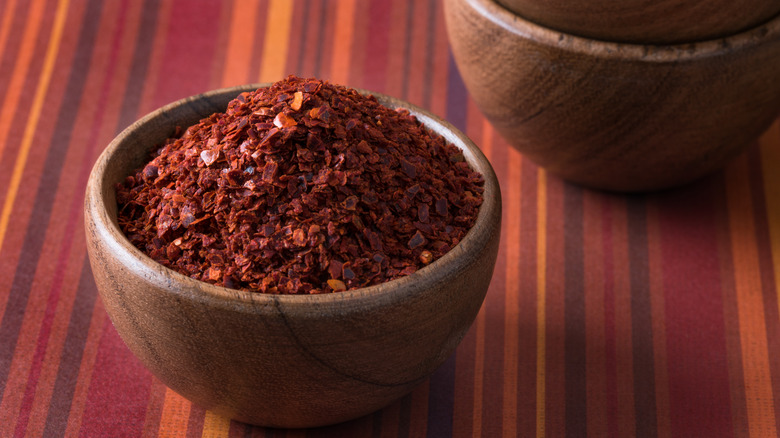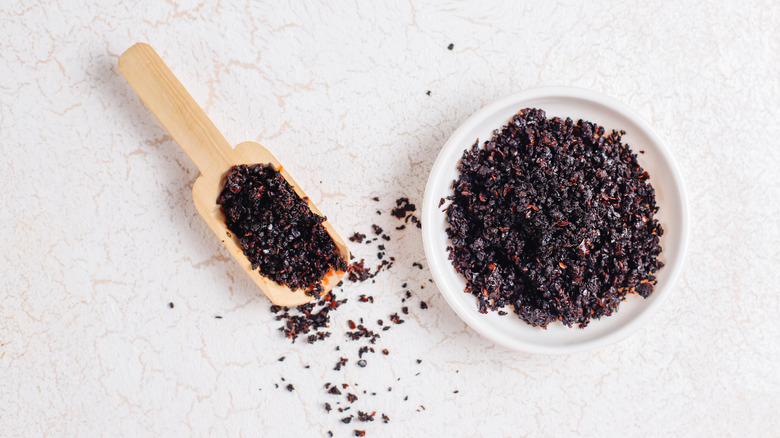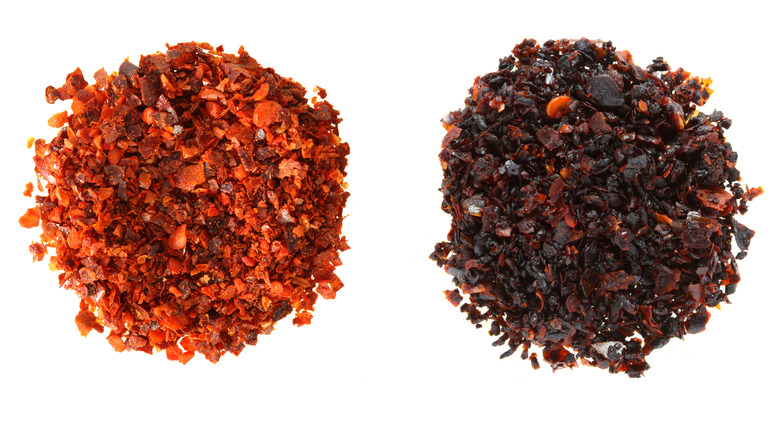What Makes Urfa Different From Aleppo Pepper?
Peppers are global fare — it might just be more difficult to find a cuisine that doesn't utilize them. Spread first through the Columbian exchange, then by Portuguese traders, and later by Turk traders on the silk road, chilies ended up domesticated in many regions. Resulting not only in different breeds, such globalization also incited varying culinary uses — drying, powdering, smoking, or fresh applications, notes alimentarium.
Such human expansion explains why Aleppo, a city in Northern Syria, is so interlinked with its namesake dried pepper. Once an important stop on the Silk Road, its beloved adopted chili became a widespread table-side condiment and commodity in marketplaces, (via Riverfront Times). Just across the border in Turkey, a similar pepper named Urfa plays a similar role. A condiment born of trade, this spice is used as freely as black pepper, per The Chili Workshop. These two peppers warrant a whole lot of comparison. Yet, especially when it comes to culinary applications, it's also important to distinguish the two. Urfa and Aleppo, what's the difference?
Urfa and Aleppo peppers are traditionally grown in different regions
The most prominent distinction between the peppers is the associated growing region. Aleppo peppers hail from Northern Syria, traditionally harvested and processed around their namesake city. Due to the ongoing conflicts in Syria, these chili flakes are drastically less exported, so it's become much more difficult to find them in their original form. Even though some growing operations have shifted over the border to Turkey and elsewhere, the resultant product doesn't always replicate Aleppo's esteemed flavor. In addition to cultivating peppers with the correct seeds, it's also necessary to employ Syrian drying and fermenting methods, explains National Geographic.
In the same manner that Aleppo peppers encapsulate their origins, Urfa peppers reflect their namesake town in Turkey, just a stone's throw from the Syrian border. Unlike Aleppo's salt fermentation, these dark chilies are dried in a bag or fabric to retain a satiated oil content, notes Food & Wine. Aleppo's current shortage means more are turning to Urfa as a substitute. Although they are cousin chilies, the peppers do exhibit some major flavor differences, (via The New York Times). Let's examine how to delineate the two.
Urfa and Aleppo chiles have distinct flavors and uses
The differences start visually — Aleppo's are a vivid red color. The flavor aligns with the visual cues, with a brightness reminiscent of tomatoes and lemons, backed by savory spice undertones. The heat is relatively mild, packing in 10,000 Scoville units, notes Cooking Light. Aleppo's spice builds slowly and is accompanied by its bright zing, making it a popular finishing spice, component in sauces, or marinade base.
After processing, Urfa Biber flakes darken to a dark blue, nearly black hue. Backed by an oil consistency, the flavor is more intense: smokey, a little bitter, and with a sweetness reminiscent of dried fruit. In addition, the pepper is way more spicey, clocking in at 50,000 to 80,000 Scoville units, per MasterClass. Its depth makes it favorable for layering in dishes, adding intensity to yogurt spread, or roasting meat and vegetables. Out of spices similar to Aleppo, Urfa is the darkest, most intensely flavored alternate. Search for Marash peppers instead as a replacement, which is like the halfway point between Aleppo and Urfa.


